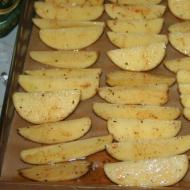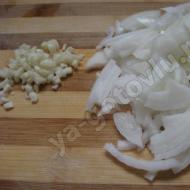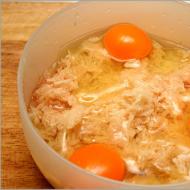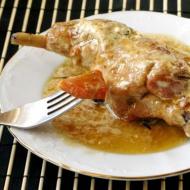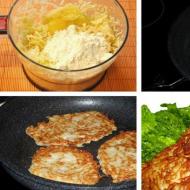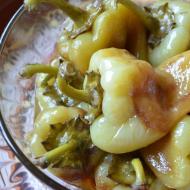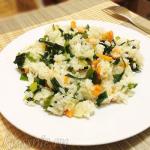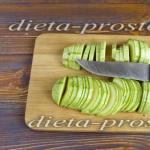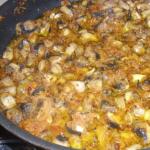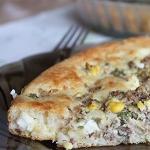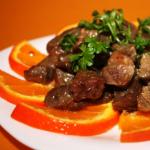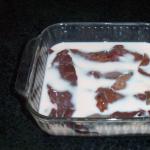
Green onion. Benefit and harm. What is a raw food diet. It looks like this
18/11/2015 14:35
A raw food diet is a philosophical way of life that people with a strong will and a pure mind can come to. Not everyone can refuse familiar dishes and put up with the constant hungry rumbling of the stomach.
So what are raw foodists anyway? People who have given up the pleasure of pampering themselves delicious food or healthy and full of strength personality? You will find the answers to these questions in our article!
What is a raw food diet and what are its types?
A raw food diet is a nutrition system in which the basis of your diet is raw foods, without heat treatment (cooking, frying, baking, smoking, pasteurization).
Proponents of such nutrition argue that the processing of products by the thermal method is unnatural, because our ancestors ate exclusively raw, natural products.
Modern culinary innovations are a tribute to fashion, which does not benefit our body in any way, as adherents of a raw food diet believe.
A well-recognised fact why so many people choose to go raw has to do with vitamins and minerals. Heat treatment destroys most of the vitamins and minerals. beneficial trace elements, and in raw food they remain intact and are better absorbed by the body.
The system of raw food diet according to the admissibility of products is divided into several types:
- Omnivorous raw food diet- in the diet you can include meat, fish, eggs in raw or dried form.
- Vegetarian raw food diet- it is forbidden to eat meat and fish, eggs and dairy products in raw form are allowed. This is the most common type of raw food diet in the world.
- Vegan raw food- excludes food of animal origin, including eggs, milk and dairy products. The vegan diet contains only raw plant foods.
- fruitarianism- this is nutrition with the fruits of plants - fruits, berries, nuts, fruit vegetables.
Raw food options also differ in the method of diet planning:
- Mixed- products are divided by composition, and in one meal they use products that are adjacent in composition - vegetables + vegetables, fruits + nuts, and so on.
- Monotrophic- in one meal only 1 product is used without heat treatment.
Where to start - how to switch to a raw food diet?
A raw food diet is not a diet, but a food system in which you refuse familiar products and from cooking with heat treatment.
Important!
A sharp rejection of an established diet can adversely affect the body. Therefore, you should switch to a raw food diet smoothly and with the realization that you really need it.
- Avoid food first industrial production, in the 2nd week - from red meat, in the 3rd - from white meat, in the 4th - from eggs, in the 5th - from fish, in the 6th - from milk and fermented milk products, from the 7th week - from cereals. Eat more raw food every week.
- Keep a diary of a raw foodist, where you will write down all the sensations, thoughts, information about harmful and useful foods, your goals (getting rid of overweight, health improvement and so on) and necessarily - the results.
- Plan your diet according to the time of year. Summer and autumn are the most favorable periods to start a raw food diet, because your diet will be dominated by fresh fruits and vegetables. In winter and spring, you can include in the menu products that are stored in the cellar (onions, carrots, potatoes, apples). In the spring, you can add more greens to your diet.
- An important factor in the transition to a raw food diet is willpower. Main principle this food system - duration. If you wanted fried fish then don't deny yourself once in pleasure. The rest of the time, eat, adhering to the raw food diet.
Benefit and harm
What are the benefits of a raw food diet?
Adherents of a raw food diet claim that by adhering to this nutrition system, you can cleanse the body of toxins, toxins and other harmful substances. At the same time, you are adjusting to a new way of life, getting one step closer to natural, simple food.
The benefits of a raw food diet include:
- Development of immunity to colds.
- Nutritional endurance. If the products contain harmful substances, the body senses them, neutralizes and rejects them without consequences for gastrointestinal tract and for health in general.
- Weight loss through food intake healthy foods without heat treatment.
- Increased energy, improved well-being, ability to drive active image life.
- Raw foodists do not receive harmful trans fats and saturated fats, which has a beneficial effect on the work of the heart muscle. Reduces the risk of developing cardiovascular disease.
Harm of a raw food diet
According to experts, a person eats fully if six elements enter the body daily - proteins, carbohydrates, fats, minerals, vitamins and water. A raw food diet does not provide enough nutrients to the body.
The disadvantages of a raw food diet include:
- Protein deficiency. Some essential amino acids are found only in foods of animal origin. According to doctors, the lack of nutrients in the body of a raw foodist leads to a decrease in immunity.
- Lack of B vitamins. Vitamins B12 and B2 are found in beef liver and in dairy products. They are important for proper metabolism and the full functioning of the central nervous system.
- Useful plant food in winter period. The raw food diet was founded in countries with a hot and humid climate, where all year round residents have access to fruits and vegetables. But the winter period in our country is characterized by a minimum fresh vegetables and fruits, as well as their dubious usefulness. Most often, greenhouse products contain a lot of harmful chemical additives, which means they will no longer be useful.
To whom is a raw food diet contraindicated?
- With diseases of the gastrointestinal tract (acids in fresh produce irritate the gastric mucosa).
- When allergic reactions on some products (nuts, citrus fruits, pollen).
- In addition, experts do not recommend switching to a raw food diet before the age of 30. Before this age mark, some processes in the body are still actively formed, but after 30 years the body is already fully developed.
- A raw food diet is also contraindicated for pregnant women, since good nutrition is important for the full development of the fetus. protein nutrition.
Raw food rules and tips for beginners - what are the most common mistakes beginners make?
You already know that the transition to a raw food diet should be gradual so as not to injure the body. However, novice raw foodists often admit typical mistakes at the beginning of your journey.
Beginning Raw Foodists Mistakes:
- Lack of water. Many novice raw foodists believe that they get enough water from plant foods, but this is not the case. In addition to plant foods, a person should consume at least a little purified water in order to saturate the body with it.
- Lack of green vegetation. There is a danger that raw foodists do not have enough animal protein. To make up for this deficiency, greens (parsley, onion, dill, celery, nettle) and nuts should be eaten.
- The use of vegetable oils in the diet, a large number dried fruits, honey, canned, fermented foods. Oils are concentrated foods that contain a lot of fat. And fat disrupts metabolism and impairs work digestive system. Dried fruits for raw foodists are acceptable when raw food temporarily unavailable (for example, on the road).
- Binge eating. Abuse of food leads to drowsiness, lethargy, lack of energy, heavy morning rise. Over time, you need to reduce the amount of food eaten. Regular exercise or at least jogging helps to strengthen muscles and cleanse the body. By itself, raw food will not strengthen your muscles and will not make you healthy if the sofa is your best friend.
Raw food diet - we make the right menu for 7 days
Monday:
Breakfast. 2 bananas, 1 kiwi.
Dinner. Green buckwheat salad fresh cucumbers with tomato, onion and sweet pepper, seasoned olive oil cold pressed.
afternoon tea. A handful of any raw nuts.
Dinner. 1 cup vegetable smoothie (tomato, avocado, basil, herbs)
Tuesday:
Breakfast. 2 persimmons.
Dinner. Sprouted with tomato and greens of onion, garlic, parsley.
afternoon tea. Raw carrot cutlets.
Dinner. Salad of tomatoes, mushrooms and cheese.
Wednesday:
Breakfast. Fruit and vegetable smoothie.
Dinner. Pumpkin porridge With linseed oil and pumpkin seeds.
afternoon tea. 2 apples.
Dinner. Squash caviar with rye bread.
Thursday:
Breakfast. 2 slices of fresh melon.
Dinner. vegetable cream soup (from onions, cauliflower, carrots, young peas and greenery).
afternoon tea. Salad of fresh cabbage, cucumbers, herbs, seasoned with lemon juice and linseed oil.
Dinner. Sprouted wheat porridge with blackcurrant.
Friday:
Breakfast. 1 cup banana and strawberry smoothie.
Dinner. pumpkin porridge with pine nuts, zucchini salad with herbs.
afternoon tea. 2 oranges.
Dinner. Arugula, cauliflower and tomato salad with sesame seeds, dressed with lemon juice and olive oil.
Saturday:
Breakfast. A handful of fresh strawberries.
Dinner. Sprouted chickpeas, salad of young zucchini and carrots in Korean.
afternoon tea. Apples stuffed with dried fruits.
Dinner. Seaweed, broccoli, onion salad dressed with lemon juice and linseed oil.
Sunday:
Breakfast. Smoothies from kefir and blackcurrant.
Dinner. Gazpacho soup.
afternoon tea. A handful of any nuts.
Dinner. from vegetables.

1. Unripe fruits.
The unripe fruit contains numerous harmful substances with which nature protects the plant from premature consumption. For example, green bananas contain insoluble starches that cause fermentation in the intestines, while green apples are highly acidic and can cause heartburn.
In addition, such fruits have an acidic pH, that is, they contain dead water and will take energy from us. I myself personally checked an unripe apple today, the ORP meter showed +337 mV, despite the fact that everything is good and living water is in the "-" range. So always try to eat exactly ripe and ripe fruits.
2. Dehydrated (dehydrated) food: bread, kozinaki
In my opinion, where there is no water, there is no life, and if we eat dehydrated food, the body spends a lot of effort and its water to digest such food. After such a meal, I always have a heaviness in my stomach and I am very thirsty. Of course, at first, changes in nutrition are indispensable, since this, in turn, is a very good replacement for even more harmful bread, but it is still best to gradually reduce the amount of dehydrated food in the diet.
3. Salt
In any of its forms (marine, pink, Himalayan, cooking), it retains fluid in the body, causes swelling, increased heart rate, heaviness in the body in the morning and fog in the head. Try to give up salt for a couple of days and you will see for yourself how different you will feel and you will see that the edema has gone, which you did not even notice before, because you took it for granted.
If you are looking for sodium in salt, then you can replenish it by eating other foods: in sea kale, spinach, celery. (I highly recommend reading the book by Paul Bragg “The Shocking Truth About Water and Salt” on the topic of the dangers of salt).
4. Cereals with gluten (sprouts of rye, wheat, oats).
Enough articles have already been written about the dangers of gluten, in fact, this substance is a glue that sticks together the intestinal villi, and useful material are absorbed worse. Grains also contain water-insoluble fiber, which scratches the walls of the intestines, thickening them - again, worsening the absorption of food. Moreover, the idea is close to me that we are still frugivorous creatures by nature, and it is better to leave cereals to birds, since in nature we would not be able to eat them, so it’s better to focus on fruits in nutrition. (Read Douglas Graham's The 80/10/10 Diet)
Surely you have heard about the dangers of peanuts, you can often find information that it contains GMOs everywhere, the petunia gene is implanted in it. In addition, peanuts are not a nut, but an earthen bean, grow in the ground and often contain fungi on the outer shell, which adversely affect the liver. In addition, all legumes contain inhibitory substances that impair protein absorption.
6. Agave nectar, Jerusalem artichoke syrup, syrup carob
All products that are not sold in their original form, that is, processed, can hardly be called truly alive, since the product is best absorbed in its original form. AT this case, if you want to sweeten your food, then choose ripe, sweet whole fruits such as dates or bananas.
7. Garlic and onion
There is such a very simple and wise rule for mixing products: if you eat all the ingredients of the mixture separately with pleasure and appetite, then such a mixture will be beneficial, if not, it is better to refuse such mixing. In this case, this rule works 100%, because we never eat onions and garlic separately, and this fact speaks for itself. Garlic and onion is fire products, inciting appetite, and such food makes you overeat In addition, scientists have found that garlic contains neurotoxins that adversely affect brain cells.
Back in the 50s, it was proved that the reaction rate of pilots who consumed onions and garlic was reduced several times, so they are contraindicated to eat these products before the flight.
8. Cocoa, coffee
Cocoa and coffee are the most processed crops in the world, and all these chemicals enter our body along with these beans.
The caffeine in these products is very strong stimulant, which speeds up the heartbeat, increases body temperature, has a slight narcotic effect. In other words, by using these products, you kind of take a loan from the bank and you will have to return this momentary vivacity with interest at the expense of your own health. Therefore my best recommendation: Switch to carob first, which is a carob powder that tastes like cocoa, even sweeter, but has no side effects.
And for real vivacity, I recommend drinking in the morning, it really is real elixir health.
9. Fermented foods - sauerkraut, soy sauce.
What pickled products? Fermentation (fermentation, fermentation, canning) is the preparation of vegetables for the future, a method of preserving vegetables by lactic acid fermentation, during which lactic acid is formed, which affects the products (along with the added table salt) preservative action. That is, we eat the harmful products of the vital activity of these bacteria. Moreover, it is a harmful process of conservation, and when we unnaturally extend the life of products, we thereby shorten our own.
10. Korean salads with vinegar and spices
Vinegar is the same preservative, the strongest oxidizing agent that stops and kills all processes occurring in the product. Surely you have heard that all the internal environments of our body, except for gastric juice, are alkaline, and how important it is to eat alkalizing foods (fruits, vegetables, herbs), and numerous diseases develop in an acidic environment. (Meat, dairy, bread, soda, vinegar, these are just harmful acidifying foods) Again, these foods
very stimulate the appetite and make you overeat.
So I highly recommend reducing these foods in your diet. Julia Lenochkina
In people with traditional food It is generally accepted that onions and garlic are very useful products, in which there are many vitamins and nutrients, as well as which treat them for various diseases and colds. But when the human body is clean, like raw foodists and fruitarians, these plants are far from harmless.
Onions and garlic are toxic. Especially garlic. It contains a sulfanyl-hydroxyl ion, which penetrates into the blood of the meninges. And also garlic causes inhibition of the brain. Having eaten it at least a little bit, a person becomes several times more inhibited. This can be felt especially well by those who are engaged in intellectual or creative work. Therefore, pilots are often forbidden to eat it before flights. Garlic completely upsets the functions of thinking. It is poisonous and very quickly penetrates tissues, causing harm, including the human brain.
“Even gardeners know that many pests can be killed with garlic.
- Garlic causes headache, inattention or absent-mindedness.
Onions and garlic make a person aggressive.
Therefore, both of these foods should be excluded from your diet if you are a raw foodist. The fact that it is impossible to eat onions and garlic mono, separately from other products, is another excellent indicator that they do not bring any benefit, only harm. I remind you, harm to our microflora and our brain! The present is incompatible with onions, garlic and other vigorous things like hot pepper etc. If you want to carry out an effective cleansing of the body, then it is better to do it with healthy raw food products (more).


Leaf garlic is just as harmful as root garlic:

By the way, this also includes a vigorous variety of wild garlic. There are more soft varieties, which really are mono, but still you should not abuse wild garlic.

The raw food diet is now a popular food system that does not leave anyone indifferent. Some consider the raw food diet to be a philosophical way of life, thanks to which you can lose weight, improve health and extend your life.
Others do not share this optimism, believing that raw foodists doom themselves to a life of starvation and cause irreparable damage to health by refusing any food processing.
So who are these raw foodists? Happy and full of energy personalities or people who have deprived themselves of the pleasures of modern cooking? We will answer all your questions, and at the same time we will tell you about what constitutes a raw food diet for beginners.
What is a raw food diet
The raw food diet is a special food system that recommends eating only plant foods, without heat treatment (no boiling, frying, baking, smoking or pasteurization).
It is worth saying that there are several types of raw food diet, for example:
- Raw food is omnivorous. Allows the use of meat, fish and eggs, as well as any vegetables, fruits and herbs, only in raw form.
- Raw food vegetarian. Prohibits the consumption of fish and meat, but allows the inclusion in the diet of eggs and dairy products only in raw form. By the way, a vegetarian raw food diet is the most common type of such food in the world.
- Raw food is vegan. With this approach to nutrition, any food of animal origin, including eggs and milk, is excluded from the diet. A vegan diet is all about eating plant-based foods.
- Fruitarianism. This is one of the most in-depth forms of raw food diet, which involves eating the fruits of plants, in particular fruit vegetables and fruits, nuts and berries.
The benefits of a raw food diet
People who are passionate about this approach to nutrition consider heat treatment of products unnatural, because our ancestors ate exclusively raw, natural products, which means that a raw food diet is a return to its natural beginning.
Moreover, it has long been proven that heat treatment a significant part of vitamins and minerals dies, while in raw foods useful substances are stored in full, and besides, they are better digested by the body.
But there are other, much more serious reasons to become a raw foodist.
For example:
- eating exclusively raw plant foods, you can cleanse the body of toxins, toxins and salts of heavy metals;
- in raw foodists is strengthened the immune system and developing resistance to infectious diseases;
- by eliminating animal fats from the diet, a person loses weight naturally, which not only guarantees him slim figure, but also prevents the development of a number of serious diseases caused by overweight;
- rejection saturated fat and harmful trans fats have a beneficial effect on the functioning of the heart and blood vessels, which means it prevents a number of diseases of the cardiovascular system;
- Raw food diet improves the tone of the body, increases efficiency, improves mood and reinforces the desire to lead. healthy lifestyle life;
- the so-called “food endurance” increases, thanks to which the body begins to better determine and reject the harmful substances present in the products without harm to health.
Harm of a raw food diet
But there is another opinion, according to which eating vegetables and fruits alone can cause irreparable harm health. It is known that good human nutrition involves the use of 6 elements (fats, proteins and carbohydrates, vitamins, minerals and water). And with a raw food diet, a person is simply not able to receive all these elements in the volume he needs.
- Lack of protein food. It must be understood that some essential amino acids are present only in animal foods. According to doctors, losing the intake of these products, a person weakens his immunity.
- Lack of vitamins of group B. Experts draw attention to the fact that vitamins B2 and B12, which are important for the nervous system, enough are found only in milk and beef liver, and therefore depriving yourself of these products, you can disrupt the functioning of the central nervous system and proper metabolism.
- Lack of healthy plant foods in winter. You need to understand that the raw food diet originated in hot countries, where plant foods are freely available all year round. But the inhabitants of our country will be able to eat natural products only 6-7 months a year, while the rest of the time they will have to buy overseas vegetables and fruits, not always good quality. It's no secret that greenhouse-grown products contain a lot of chemical additives. In this case, the benefits of a raw food diet can be reduced to zero.
Who is contraindicated raw food diet
These include:
- persons with diseases of the gastrointestinal tract (the acid present in raw foods strongly irritates the gastric mucosa);
- allergic reactions to certain foods (citrus fruits, honey or nuts);
- pregnancy (women during the period of bearing a child need a complete protein diet, which cannot be achieved without eating meat and offal);
- experts do not recommend switching to a raw food diet for people under 30 years old, since before this age some processes in the body are still being formed. And after 30 years, the body is already fully developed;
- persons over 70 years old, whose body is in the process of withering, are not recommended to switch to a raw food diet;
- people who are underweight, who have recently had surgery or who suffer from anemia should also not switch to a raw food diet.
Read also:
- Raw food - 10 Simple Recipes On every day
- Essential Enzymes For Digestion
- A couple of glasses of wine at night - is it alcoholism?
Books on the raw food diet
Before you become a raw foodist, it's a good idea to read the beginner's guide. There are plenty of books on this topic on the Internet, but we would recommend you the following literature:
- “Raw food. A guide for beginners" - author Sergey Zdravin.
- "Eating Raw" by Carol Alt.
- The China Study by Colin Campbell.
- "Green for life. The real story of recovery "- author Victoria Butenko.
How to switch to a raw food diet
It is important to understand that a raw food diet is not a diet, but a way of life, and therefore, before making changes to your diet, you should understand why you need it. By the way, most raw foodists agree that such food not only benefits the body, but is also a means of spiritual growth.
Only fully realizing that a raw food diet is exactly your path, you can proceed directly to the transition to the use of plant foods. At the same time, remember that a sharp rejection of your usual food can adversely affect the state of the body, and therefore you need to start with a gradual rejection certain products.
It looks like this:
- 1st week: give up all products that the industry produces (sausages, sausages, confectionery);
- 2nd week: eliminate red meat;
- 3rd week: give up white meat;
- 4th week: eliminate eggs;
- 5th week: give up fish;
- 6th week: remove milk and dairy products from the diet;
- 7th week: give up cereals.
At the same time, more and more plant foods should get into your diet every week.
You will need to keep a raw food diary to record your feelings, information about harmful products, as well as the goals that you are trying to achieve through a raw food diet. A separate column in the diary should indicate the results of your work, which will motivate you to maintain the chosen nutrition system.
The most favorable times of the year to start the transition to a raw food diet will be summer and autumn, because during these periods on your table there will be an abundance of all kinds of vegetables and fruits. As for winter, during this period, the food stored in your cellar (apples, potatoes, carrots, cabbage, beets and onions) will form the basis of nutrition. In the spring, your diet will get fresh herbs, Jerusalem artichoke and radish.
And further. An important factor in the transition to a raw food diet should be willpower, without which it will not be possible to stick to the chosen diet for a long time. That is, if suddenly you are irresistibly drawn to eat a piece fried meat, do not deny yourself this, but such temptations should not become systemic.
Beginner Raw Foodist Mistakes
As we have already learned, it is necessary to come to a raw food diet gradually, giving up certain foods week after week. If you refuse animal food in one fell swoop, there is a high risk of “breaking loose” and returning to the previous diet. But there are other mistakes that beginner raw foodists make.
- Lack of water. After starting to eat exclusively plant foods, some people believe that they get enough water from green foods. Actually it is not. Whatever your diet, you should drink at least 6-8 glasses of pure water per day.
- lack of greenery. When switching to a raw food diet, the risk of a lack of animal protein in the body increases. To cope with this problem, it is necessary to include greens (lettuce, parsley, dill, nettle and celery) in the diet more often, and also eat nuts.
- Excess consumption of vegetable oils, dried fruits and honey, fermented and canned food. Oils contain a lot of fat, which interferes with the process of digestion of food. Dried fruits and honey also should not be consumed constantly, these products should be switched only when plant foods are not available.
- Binge eating. It should be remembered that by eating too many vegetables and fruits, you run the risk of lethargy and apathy, drowsiness and lack of energy. Over time, it will be necessary to reduce the amount of food consumed.
- Lack of physical activity. By themselves raw vegetables and fruits will not strengthen your muscles and improve your body, if you do not pay attention at the same time exercise. Jogging in the morning, exercising or going to the gym should be regular in order to maintain a healthy mind in your body and strengthen your muscles.
Raw food for weight loss
The transition to the use of raw plant foods in order to get rid of extra pounds, has many advantages. Firstly, due to the large amount of fiber, the body is quickly cleansed of toxins and toxins. Secondly, the absence of fats and carbohydrates in the diet allows you to quickly lose weight, spending your own fat reserves. Thirdly, with a raw food diet, the amount of food consumed is reduced.
Thermally unprocessed food has a coarser texture, which takes more time and energy to process. Finally, people who practice a raw food diet gain not only beautiful figure but also activity and clarity of mind.
Approximate daily diet of a raw foodist
- 45–50% raw fruit and berries;
- 30-40% raw vegetables;
- 10–15% legumes and grains;
- 5-10% nuts, seeds, dried fruits and honey;
- 1% vegetable oil, garlic and spices.
Sample menu of a raw foodist in the summer
Cucumbers + radishes + parsley + dill + lettuce;
Nettle + tomatoes + dandelion leaves;
Carrots + cucumbers + leafy green vegetables;
Bulgarian pepper + tomatoes + greens;
White cabbage + apples + peaches;
Carrot + cauliflower(broccoli) + peaches;
Plums + cabbage + apricots;
Several types of berries + cabbage;
Sweet apple + blackcurrant + nectarines;
Zucchini + cabbage + cucumbers;
Zucchini + sour apple+ leafy greens.
Sample menu of a raw foodist in winter
Apple + carrot + celery root;
Carrot + cabbage + apple;
Apple + beets + prunes;
Carrots + cauliflower + garlic + beets;
Turnip + pumpkin + apple;
Broccoli + cauliflower;
Apple + dried apricots + radish (rutabaga).
In winter, you can include in the diet exotic vegetables and fruits, always in combination with the usual products:
Orange (grapefruit) + banana + apple;
Carrot + Chinese cabbage+ orange;
Apple + cabbage + orange;
Orange + carrot + seeds;
Sweet and sour apple + orange + dates;
Avocado + pistachios.
At the same time, for breakfast, you can prepare salads with the addition of cold-pressed oil, adding, if desired, lemon juice, honey, Apple vinegar, mustard powder or garlic.
By the way, any salad can be seasoned with nuts or seeds, which were previously soaked in water for 8 hours. room temperature. For this purpose, almonds and walnuts are best suited. Pine nuts, as well as pumpkin seeds and sunflower seeds.
Drinking on a raw food diet
- The main source of moisture for the body of a raw foodist should be the usual pure water(not boiled!)
- Vegetable and fruit juices will benefit, which should be drunk immediately after preparation, so that the body receives a maximum of vitamins.
- You can pamper yourself with the milk of young coconuts.
- Solar tea. For its preparation, tea leaves or healing herbs dried, and then filled with water and infused in the sun.
- They consume raw foods and alcohol. However, it must be natural. grape wine, prepared at home without special processing. In small quantities (1 glass per week), such wine will bring health to the body.
Raw food secrets for beginners
And now we will reveal a few secrets that will help you easily switch to a raw food diet and stick to this way of eating for many years.
- Eat only when you feel hungry. At the same time, you can get 5-6 meals a day.
- Food must be chewed slowly and thoroughly.
- While eating, you should not be distracted by extraneous activities (talking, watching TV or reading books).
- You should not overeat.
- You don't need to eat before exercise.
- Drink water after eating should not be earlier than 30 minutes. A similar interval must be maintained before meals.
- The food taken should be at room temperature, which means that after taking it out of the refrigerator, you should let it stand and warm up.
- The prepared dish should be eaten immediately, without leaving the next day, so that the vitamins do not disappear.
- You need to have dinner no later than 19:00, and dinner should be complex.
- In every possible way alternate products among themselves, but make sure that the body receives the required amount of calories per day.
Health to you and victories over yourself!
Hi all!
I want to continue talking with you about how to improve your diet by using planning and analysis. I am sometimes asked questions, like: where to find the strength to switch to a raw food diet, what and in what order to eat, how to avoid breakdowns and feel improvements, etc. I myself am looking for answers to them by trial and error, on own experience, in the process of finding which I share some observations.
1. The combination of vegetable raw LIVE food with dead or animal food, i.e. "raw-eating corpse-eating" This is the biggest and most common mistake newbies make.
- honey(antibiotic, also of animal origin) and other bee products (in particular, pollen);
- bran, carob(products of industrial production);
- dried berries, fruits, vegetables, seaweed(they are no longer alive) - I eat quite a lot of dried fruits (especially dates, figs, less melon, raisins, dried apricots, prunes purchased on the market; bought from grandmothers dried apples, pears, cherries - for compote); rose hips, carrots, eggplants grown and dried at home; dried fucus, kelp;
- frozen berries and vegetables(non-living) - I like to indulge in thawed cranberries with honey or in salads, strawberries (in smoothies), green peas;
- garlic, onion(toxic) - during the transition period I ate quite a lot of them, now it has “cooled down”, I almost don’t use it, but sometimes I want garlic;
- sauces, vinegar, oils- natural soy sauce, apple cider vinegar - rarely, corn oil cold pressed - sometimes, but flaxseed - quite often, although not more than 1 teaspoon per serving;
- tap water, bottled water- it's good that we have a well in the village, only the water from there starts to "bloom" very quickly, willy-nilly, we have to save ourselves with bottled mineral water.
This can also be attributed use of salt, seasonings, spices- all this is inanimate; dried herbs are also dead. Of the items listed in this paragraph, I used:
- sea salt (not herbal product), ground black pepper;
- dried herbs from your garden (dill, watercress, basil, mint, etc.) - but rarely, because there is still enough fresh greenery;
- dried in the shadow shrub leaves from your site (cherries, currants, raspberries, etc.) - rarely, because I drink mostly raw water;
Purchased dried tomatoes as a seasoning for sprouts - rarely.
2. Abuse of nuts, the use of inanimate nuts.
In the first three months - very likely. She could eat them three times a day, did not soak them, mixed them with each other and with honey, did not withstand intervals for digestion. Now I eat them about 1 glass a day, three times a week, soaked. I think, however, that this is quite a lot. I have not decided for myself whether to eat them for dinner, as Zeeland advises, or for lunch, as supporters recommend separate power supply. For me, both are inconvenient. By lunchtime, I still do not have time to get hungry, and the interval of six hours during the day is quite difficult to maintain. And at night it is too heavy and plentiful food. I usually eat them at the fourth meal (out of five) - sort of like a late afternoon snack.
As for non-live nuts, I have now found my supplier (his products are presented in our Live Foods Store), at the beginning of the raw food diet I bought nuts and dried fruits in stores, so I do not exclude that I used chemically and thermally processed ones.
3. Constant anxiety and thoughts about food.
It is what it is. Sometimes there is a feeling that you live from one meal to another. All life, all thoughts revolve around these techniques. Sometimes something fascinates, and you don’t think about food at all. But sometimes a zhor attacks, and more of a psychological nature (it seems that you don’t want to eat, but you irresistibly pull to put something in your mouth as quickly as possible until withdrawal starts). It is interesting to observe your addiction when you can recognize it and understand that it should not be like this. I try to find interesting activities for myself every minute, so as not to reach for another apple out of boredom.
4. Abuse of sprouts of legumes and cereals.
Not that it was abuse ... In the first month I ate a lot of them - at least twice a day (and on the same day I ate nuts, sometimes even unsoaked). Then I started eating only once a day. Even later - three or four times a week. Now I eat them even less often, more and more preferring fruits. I do not even arrange a protein meal every day, I alternate sprouts with nuts and seeds. Of all the types of sprouts, I most often eat green buckwheat, less often - red lentils, even more rarely - chickpeas. The rest in the last couple of months somehow do not feel like it, especially grain.
5. Lack of sleep and erratic sleep patterns.
(I sigh heavily) What is, is ... Deep "owl" in person. During the day, there is no opportunity to do everything you love, you have to catch up at night, when everyone is sleeping and no one is distracting. Interestingly, when the electricity was turned off for a week in our village, I naturally fell asleep at ten in the evening and got up early in the morning. When the light was given, she even went to bed early, but could not fall asleep.
6. Inattention to one's own digestion, neglect of the rules of a healthy combination of products and the use of complex mixtures.
Recently, I try to eat mono. The body responds with gratitude. Recently there was an instructive case: it was unrealistic to want hummus. I made it with garlic, I was very satisfied and full, but ... about a week after that, the stomach responded with excruciating pain to any combination of products. She was saved by mono-eating a small amount of fruit. Now it’s better, but I don’t do such experiments anymore. Although any "explosive mixtures" went normally at the transitional stage - apparently, after dead food and complex raw meals were perceived by the body with a bang. From time to time I make salads for myself (with sprouts, vegetables and fruits), but I try to combine the minimum number of components, I do not use salt and pepper.
7. Negligent attitude to the condition of the teeth - teeth should be brushed with a regular brush, but without paste.
There were costs of fanaticism when I believed that raw foodists should not brush their teeth - they began to hurt, the gums became very inflamed. She saved herself by cleaning after each meal, infusions of herbs (chamomile, plantain). Now, of course, I brush my teeth regularly: sometimes with a small amount pasta, sometimes without pasta. I also brush my tongue every day. I haven’t been fond of gum balms with fluoride before, now I don’t use them at all.
8. Inattention to such a factor as the feeling of hunger.
I still eat "by the clock", for company or out of boredom, due to psychological anxiety, dependence - usually without waiting for the natural feeling of hunger to arise. But sometimes I'm so busy or passionate about something that I don't eat for a long time, and then I manage to feel it.
9. Absence physical activity, neglect of staying on fresh air.
Yes, the activity is mainly at the computer, leisure time for needlework. However, from our country "residence" to the nearest bus stop - about thirty minutes walk, so willy-nilly have to move. I do it with pleasure, I love to walk. Sometimes you have to come back from the store with weights. In the summer I rode a bike, now we have strong winds and impassable mud, I had to postpone this activity until spring. I just can’t do gymnastics - I can’t find a suitable complex. I used to love exercises with dumbbells, but after abdominal surgery about this form physical activity had to forget. In general, in this regard, I am not very satisfied with myself yet: the body asks for movement, but I don’t give it to it, I plan and analyze everything. :-)
As for being outdoors, in the summer I try to do everything outside, I do a lot of gardening. In the cold season - yes, I walk much less. However, the air in our country is much better than in the city itself. You begin to understand this, already approaching the stop. Recently, it has become more and more difficult to travel in public transport: the smell of gasoline is unbearable, and if the driver also smokes ... spasms in the throat, nausea, headache. I don’t understand how people can live in the city and not even notice what they breathe?
I don't have this. I drink only raw water, less often - water in which dried fruits were soaked, linen kissel on this water. I almost don't drink juices. there are no juicers on the farm, but you don’t want to bother with squeezing through cheesecloth. And why, when you can eat whole, juicy, delicious fruit? In the summer when there was an excess own pears and plums, she could still do it, but even then she did not abuse it. Different types nut "milk" is also a troublesome task, so I usually eat soaked nuts and seeds whole. Smoothies were carried away only at the transition stage. So this error is not relevant for me.
However, some consider food fruit juices even more perfect than a separate raw food diet. So, Evgeny Lomakin is among the mistakes

